"Standard" battleships of the USA, Germany and England. American "Pennsylvania". H. 2
How did the American battleships shoot? Dear A.V. Mandel, in his monograph "US Battleships", gives a detailed description of two such episodes, and the first one is the test shooting of the battleship Nevada for 1924-25. (more precisely, one of the test shooting). Judging by the description, during this period of time the Americans used the progressive shooting training system, which, as far as the author of this article knows, was first used by the Germans before the First World War. As you know, the classic naval artillery exercise is shooting at a shield, but it has one serious drawback: the shield cannot be towed at high speed. Thus, shooting at a shield is always shooting at a very low-speed target.
The Germans decided this question cardinally. They conducted training shooting at the real goal, for the battleships usually used high-speed cruiser. The idea was that the battleship artillerymen determined the data for firing at a real high-speed ship (the cruiser usually went at 18-20 speed knots), but at the same time adjusted the horizontal pointing angle so that the volleys lay not on the cruiser, but in several cables behind it . Thus, the ship simulating the target seemed to be out of danger, at the same time there were artillery observers on it, who recorded the fall of the volley of the practicing ship relative to the wake of the “target”. This, in fact, determined the effectiveness of the shooting.
Judging by the description of A.V. Mandel was exactly the way Nevada fired, with the target ship moving at 20 speed. 90 cabling is likely on the course. The word "probably" is used because the distinguished author indicates not meters, but meters (16 500 m), however, in English literature, as a rule, not meters, but yards are indicated, in this case the distance was only 80 cables. The shooting was supposed to start when the course angle on the target was 90 degrees, but the order to open fire came earlier when the target was on 57 degrees. and the first two battleships the battleship made during the ongoing reversal, which, in general, did not contribute to the accuracy of the shooting. In total, during the shooting, the battleship gave 7 volleys in 5 min. 15 seconds
After the first salvo, the turning mechanism of one of the towers failed, but apparently it was possible to “reanimate” the second salvo already, so there was no pass. However, the left cannon of the first turret missed the first and second salvo due to a failure in the electric trigger circuit. After the fifth salvo, a vertical drive failure of the 4 tower was fixed, but he was also put into operation and the tower continued to participate in the shooting. During the 6 salvo, the left gun of the third turret gave a pass due to a defective fuse, and in the final 7 salvo, one gun fired with an incomplete charge (3 card instead of 4), and the vertical pickup drive failed again, now in tower No. 2.
A.V. Mandel writes that such faults were a rare case, and moreover, on the Nevada they were quickly corrected during the shooting, but it is not easy to agree with the respected author. If we were talking about some unscheduled maneuvers, or shooting, which took place shortly after it was put into operation, when many mechanisms still need to be improved, then this could somehow be understood. But after all, the date of test shooting is known in advance, and the crew and the materiel are being prepared for it - and, in spite of all this, such an abundance of small failures. We will notice, failures as a result of our own firing only, and what would have happened if “Nevada” had been in combat and had been exposed to large-caliber projectiles of the enemy?
As we said earlier, the American battleships fired full volleys, and with three passes, the Nevada launched 7 shells for 67 volleys, one of which obviously could not hit the target, since it was released with an incomplete charge. But this is not a breakdown of the equipment, but an error of the loaders who did not report one cap to the chamber, so we have no reason to exclude this projectile from the general result of the shooting.
The first four volleys laid a covering, but there were no hits; on the 5, observers counted one hit on the battleship, and two more hits on the 6 and 7 shots. And the total 5 hits on 67 spent shells, respectively, the accuracy was 7,46%.
A.V. Mandel calls such accuracy an outstanding result, citing the fact that the famous Bismarck showed less accuracy during the battle in the Danish Strait. But such a comparison is completely incorrect. Yes, indeed, Bismarck spent 93 shells in that battle, having achieved three hits in the Prince of Wells and at least one in Hood. It is possible that the Bismarck gunners achieved a greater number of hits in the dead British cruiser, but even considering the minimum, we get that the Bismarck showed an accuracy of 4,3%. This, of course, is lower than the Nevada indicator in the shootings we described above. But it should be taken into account that the American battleship fired at one target following the same course, while the Bismarck fired successively at two different ships, so it required a second fire, and, accordingly, an increased consumption of shells for it. In addition, during the battle the English ships maneuvered and getting into them was much more difficult. Also, one must not forget that Nevada shot at 90 cables, and in the Danish Channel the battle started at 120 cables and, possibly, Bismarck destroyed Hood before the distance between these ships decreased to 90 cables. There is still some doubt that the visibility during the battle in the Danish Strait was as good as at the Nevada firing: the fact is that the Americans sought to conduct their training firing in clear, good weather so that without interference watch the falls of volleys of training ships. It is interesting that in the United States there were opponents of such "preferential" combat training, but their objections were usually countered by the fact that in the tropical regions of the Pacific Ocean, where, according to admirals, they had to fight the Japanese fleetSimilar visibility was the norm.
But the main objection of A.V. Mandela lies in the fact that, as a rule, in combat, the accuracy of shooting is reduced severalfold or even by several orders of magnitude relative to that achieved in pre-war shooting. So, at the beginning of 1913, in the presence of the first lord of the Admiralty, the battleship "Thanderer" adjusting the shooting at a range of 51 KB. using the latest at the time of the fire control devices has achieved 82% hits. But in the battle of Jutland, the 3-I squadron of battlecruisers, fighting for the 40-60 cable course, achieved only the 4,56% of hits and this was the best result of the Royal Navy. Of course, the “Nevada” shot in much more difficult conditions and long range, but still its 7,46% score does not look too good.
In addition, I would like to draw attention to the fact that the first 4 volley, although laid down as a cover, but did not give hits - of course, there is any persistent feeling at sea that, despite measures to reduce dispersion, it remained with American battleships overly large. This is indirectly confirmed by the fact that the Americans did not stop at a double reduction in dispersion achieved by them in 1918, but continued to work in this direction and further.
The second shooting, described by A.V. Mandel produced the battleship New York in 1931. Despite the fact that ships of this type were equipped with two-gun turrets, in which the guns had an individual cradle, the ship achieved fairly moderate results when shooting at the cable cables 60: 7 hits for 6 volleys, or 11,67%. In comparison with the English pre-war shooting, it is not at all an indicative result, but, in fairness, we note that New York fired at a “conditional 20-nodal target” with a shift of the aiming point, the mechanism of which was described by us above, and not by the shield , and gave the first 4 volley on one target and the other three on the other.
In general, it can be stated that the accuracy of shooting American battleships raises questions even in the aftermath of the First World War, that is, after the US sailors "shook" the joint exercises with the British fleet, before that the results were obviously worse. No wonder that D. Beatty, who commanded the battlecruisers of the British, and later became the First Lord of the Admiralty, argued that for parity with the United States, England would have enough fleet, by 30% less than the American one.
But back to the design of the American three-gun turrets. In addition to placing the guns in one cradle and having only two projectiles and the same number of charging lifts for three guns, the American towers were also distinguished by another very unusual “innovation”, namely the placement of ammunition. On all the battleships of those years, the artillery cellars with shells and charges were located at the very bottom of the tower installation, under the barbet and defense of the citadel - but not in American ships! More precisely, their charge storages were located approximately in the same place as the European battleships, but shells ... The shells were stored directly in the towers and barbetts of the installations of the main caliber.
55 shells were placed directly in the turret, including 22 - on the sides of the guns, 18 - at the rear wall of the turret and 18 - at the level of the loading tray. The main ammunition was stored on the so-called “shell of the turret” - it was at the level, as VN writes. Chausov "second ship" deck. What was meant here is not clear to the author of this article (was the forecastle deck taken into account?), But in any case it was located above the main armored deck, outside the battleship citadel. Up to 242 shells could be stored here (174 at the walls of the barbet and 68 in the reloading compartment). In addition, below, already within the citadel, there was still 2 backup storage: the first of them was located on the barbet section located under the main armored deck, there could be up to 50 projectiles, and 27 projectiles could be placed at the level of charge storage. These stocks were considered auxiliary, since the delivery of shells from the lower tier of the barbet and lower vault was extremely difficult and was not designed to ensure the normal rate of fire of the guns in battle.
In other words, in order to be able to use the standard ammunition in full (100 projectiles per barrel), it was necessary to have it partially in the turret, and partly on the projectile deck inside the barbet, but outside the citadel. The latter protected only the powder cellars.
Such a decision is extremely difficult to call rational. Of course, the American battleships had very good reservations for barbets and towers - a little running ahead, we note that the thickness of the three-bore 356-mm turret front plate was 457 mm, the side plates - 254 mm and 229 mm. The thickness went down towards the rear wall, which also had a thickness of 229 mm, the roof was 127 mm. At the same time, the barbet, up to the armored deck itself, consisted of monolithic armor with a thickness of 330 mm. Again, looking ahead, it can be noted that such protection justifiably claims, if not the best, then at least one of the best in the world, but it, alas, was not impenetrable: the English 381-mm "greenboy" was quite capable pierce armor of this thickness with 80 cables, or even more.
At the same time, the explosive D used by the Americans as an explosive, although it was not “chimozy,” was still ready to detonate at 300-320 degrees, that is, a strong fire in the American battleship tower is fraught with a powerful explosion.
All of the above does not allow us to consider the construction of tower 356-mm installations of battleships of the “Pennsylvania” type as successful. They are listed only 2 significant advantages: compactness, and good (but, alas, far from absolute) security. But these advantages were achieved at the expense of very significant shortcomings and the author of this article is inclined to think that the three-gun towers of the USA of those times are considered to be among the most unsuccessful in the world.
Mine Artillery
Pennsylvania-type battleships were supposed to protect 22 * 127-mm / 51 artillery systems from destroyers. And again, as in the case of the main caliber, formally, the anti-mine artillery of the battleships was very powerful, and seemed to be even one of the strongest in the world, but in practice it had a number of shortcomings that significantly reduced its capabilities.
The 127-mm / 51 gantry of the 1910 / 11 g model (developed in 1910 g., Adopted in 1911 g.) Was very powerful, it was able to send a projectile weighing 22,7 kg with an initial speed of 960 m / s. The firing range at the maximum elevation angle of 20 degrees was approximately 78 cables. At the same time, the gun was not re-forced, the resource of its trunk reached quite solid 900 shots. The armor-piercing and high-explosive shells had the same mass, but the content of the explosive in the armor-piercing was 0,77 kg, and in the high-explosive - 1,66 kg, while the explosive D was used as an explosive.
However, it is somewhat surprising that in almost all sources available to the author on US battleships, an armor-piercing projectile is described exclusively. Strictly speaking, this, of course, is not evidence that the high-explosive shells in the US battleship ammunition were missing, but ... and there are no indications that the guns were equipped with such projectiles. And, as we know, the Americans provided the main caliber of their battleships only with armor-piercing shells until the Second World War.
But even if we assume that the mine caliber "Pennsylvania" and "Arizona" initially received high-explosive shells, then it should be noted a very small amount of explosives in them. So, in the 120-mm / 50 instruments of the 1905 model used in the Russian fleet (Vikkers) in the 20,48 kg high-explosive shells mod. 1907 was 2,56 kg of trinitrotoluene, and in semi-sredneboyny shells arr. 1911 g weight 28,97 kg explosives reached 3,73 kg, that is, more than twice that of the American high-explosive projectile 127-mm / 51 guns! Yes, our gun was losing American in ballistics, having a much lower initial speed - 823 m / s for a lighter 20,48 kg projectile, and 792,5 m / s for 28,97 kg, but the effect of Russian shells on the destroyer target would be different more significant.
The next, and very significant, drawback of the American cannon is the cap-loading. Here, of course, we can recall that the 120-mm / 50 mentioned above also had a crank loader, but the whole question is that on Russian ships these tools were installed either in an armored casemate (Sevastopol-type battleships, armored cruiser “Rurik”), or even in the towers (“Flurry” monitors), but on American battleships, with their “all or nothing” booking scheme of 127-mm / 51, the mine-mine guns did not have armor. And this created certain difficulties in battle.
In repelling the attackers of the destroyers, the mine battery should have developed a maximum rate of fire (not to the detriment of accuracy, of course), but for this it was necessary to have a certain amount of projectiles and charges for 127-mm / 50 guns. These stocks were not covered with armor, and here the presence of the cartridges could give them at least some protection, the hope that if such a stock detonated from the effects of fragments or fire, then at least not completely. Again - to keep the calculations of unprotected guns during the battle linear forces did not make much sense, so that in the event of a fire, they could not quickly intervene and correct the situation.
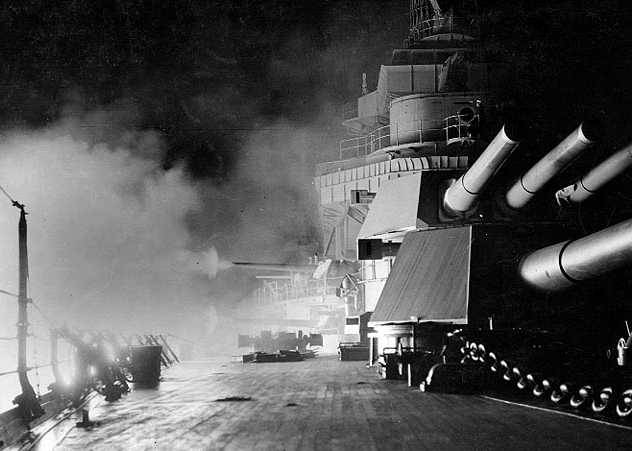
In other words, it turned out that the Americans had to either lay out and leave unattended stocks of ammunition before the battle, risking fires and explosions, but still have the opportunity, if necessary, to cause calculations to the guns and immediately open fire. Or do not do it, but then to put up with the fact that in the event of a sudden threat of a mine attack quickly open fire will not work. At the same time, the situation was aggravated by the fact that the ammunition lifts could be damaged (outside the citadel) at the time of the attack of the destroyers, and in this case, the absence of an “emergency pool” of the guns would be completely bad.
In general, all of the above is, to a certain extent, true for casemate guns, but still the latter have not the best protection for cannons and their calculations, and are also capable of providing much better safety for ammunition from guns.
In addition to the foregoing, the mine batteries of battleships of the “Pennsylvania” type, although they had a slightly better position relative to the ships of the previous type, but remained very “wet”, subject to flooding. However, this flaw in those years was extremely common, so we will not blame the creators of ships of this type.
Fire control is another matter. In contrast to the main caliber, to which the “modern” centralized fire system “attached” to “Pennsylvania” and “Arizona,” differed somewhat in design from its British and German counterparts, but was generally quite effective, and, by some parameters, perhaps even surpassed For a long time, European MSAs and anti-mine caliber tools of centralized control did not have centralized control at all and were guided individually. True, there were officers of the fire control group, whose combat posts were located on the latticework masts bridges, but they gave only the most general instructions. Centralized control of anti-mine artillery fire appeared on American battleships only in 1918.
Anti-aircraft weapons
When the battleships entered service, the 4-caliber guns of 76-mm / 50 caliber were introduced. These guns were quite equivalent to many other guns of the same purpose, which appeared by that time on the battleships of the world. Anti-aircraft "three-inch" shot with a projectile weighing 6,8 kg with an initial speed of 823 m / s., The rate of fire could reach 15-20 lines per minute. When firing, unitary cartridges were used, and the maximum angle of elevation of the barrel reached 85 degrees. The maximum firing range (at an angle of 45 deg) was 13 350 m or 72 cable, the maximum reach in height - 9 266 m. Of course, these tools did not have a centralized control.
Torpedo armament
I must say that the torpedoes were not particularly popular in the US Navy. Assuming to lead their battles over the oceans, the American admirals did not consider it necessary to build in large numbers the destroyers and destroyers, in which they saw, essentially, coastal ships. This point of view changed only in the years of the First World War, when the United States embarked on the mass construction of ships of this class.
Such views could not affect the quality of American torpedoes. The fleet used 533-mm "self-propelled mines" manufactured by Bliss (the so-called "Bliss-Levitt"), various modifications of which were adopted by the 1904,1905 and 1906. However, all of them were inferior in their performance characteristics to European torpedoes, had a very weak charge, which consisted, moreover, of gunpowder rather than trinitrotoluene, and a very low technical reliability. The proportion of unsuccessful launches of these torpedoes in exercises reached 25%. At the same time, American torpedoes had a very unpleasant habit of sticking off the course, gradually turning to 180 degrees, while the US battleships usually operated in the wake direction: thus there was a hefty danger of hitting their own battleships following the ship that had fired the torpedo.
The situation improved somewhat with the adoption of the Bliss-Levitt Mk1915 torpedo in 9, which had a charge of 95 kg of TNT, although this was very small. The course range, according to some data, was 6 400 m at 27 knots., According to others - 8 230 m at 27 knots. or 5 030 m to 34,5 knots., length - 5, 004 m, weight - 914 or 934 kg. However, to say exactly what kind of torpedoes the battleships of the “Pennsylvania” type were equipped at the time of entry into service, the author of this article is not exactly known.
“Pennsylvania” and “Arizona” were equipped with two torpedo torpedo tubes located in the hull in front of the main-caliber bow towers. In general, such minimalism could only be welcomed if it were not for ... ammunition, which already had 24 torpedoes. At the same time, the width of the ship was not enough to ensure the loading from the end of the torpedo tube, which was the classic way: so the Americans had to come up with a side loading design that was extremely tricky (and extremely overstated by the British, who had the opportunity to inspect US torpedo tubes).
At this point we finish the description of the armament of the “Pennsylvania” type battleships and proceed to the “highlight” of the project - the reservation system.
To be continued ...
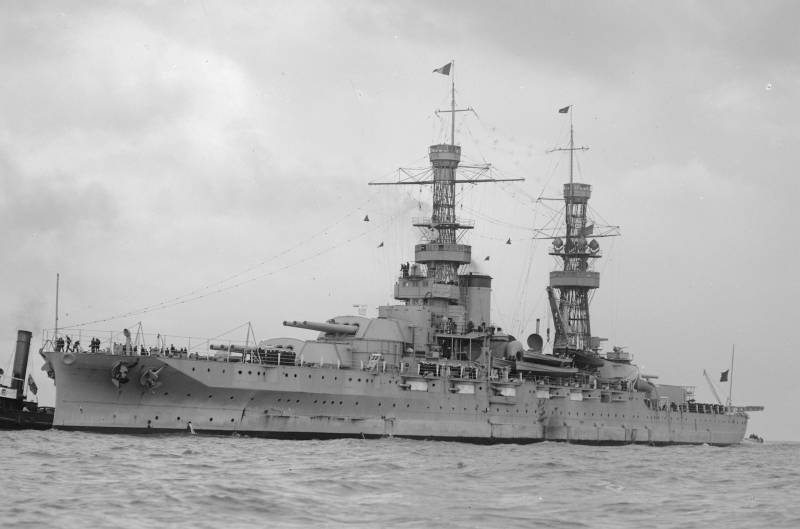
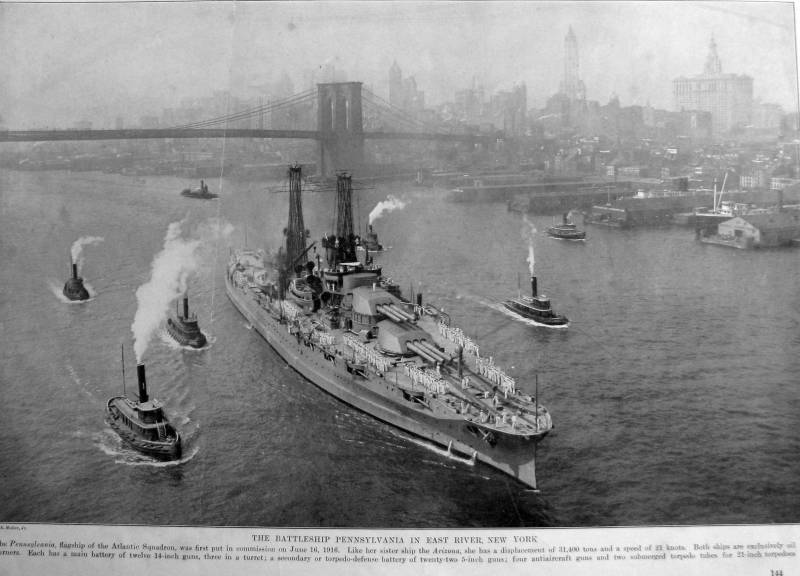
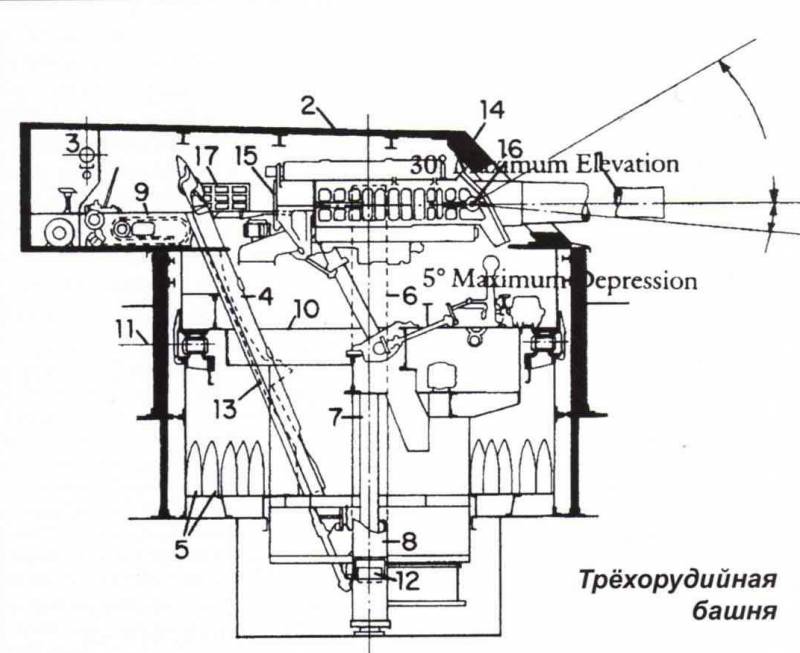
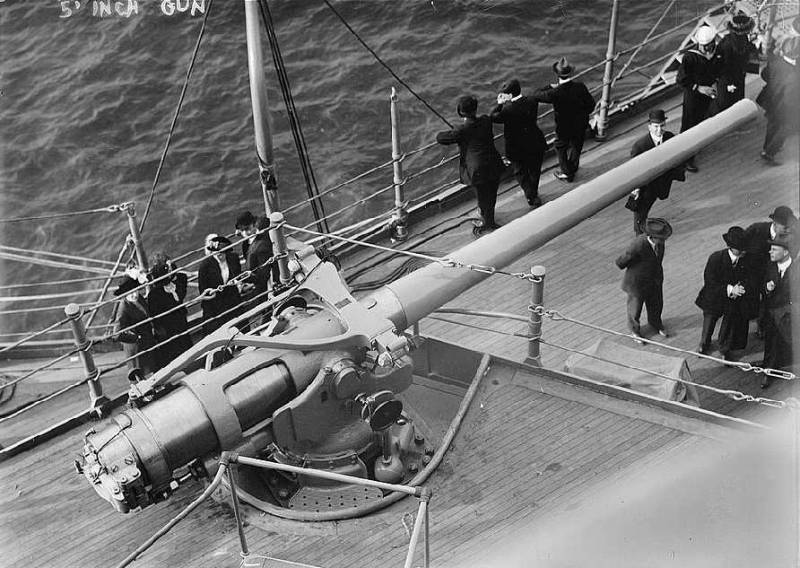
Information